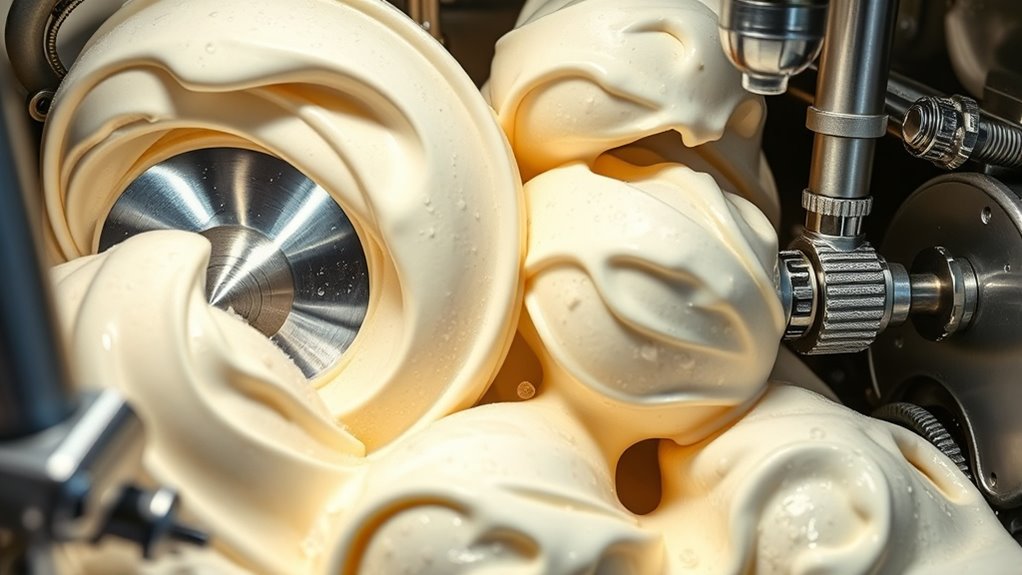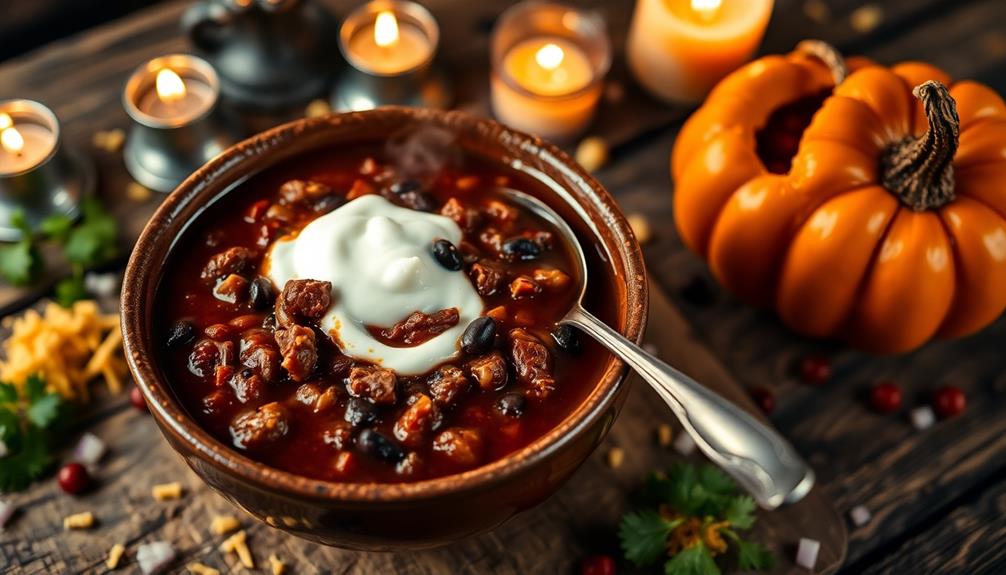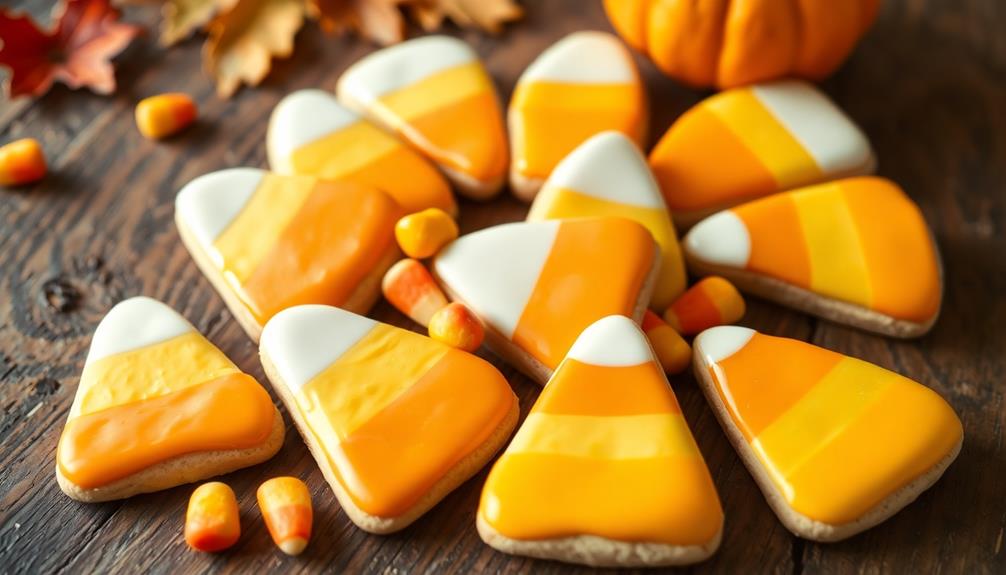The science behind ice cream machines combines thermodynamics, ingredient interactions, and engineering to produce creamy textures. You control freezing points through sugar and stabilizers, while churning creates a smooth, airy consistency by breaking down ice crystals. Emulsifiers help blend fat and water, preventing separation. Modern machines optimize cooling and ingredient mixing, and innovative techniques speed up production while ensuring rich flavor. Keep exploring, and you’ll uncover the fascinating secrets behind creating perfect frozen treats!
Key Takeaways
- Ice cream machines rely on precise temperature control and rapid cooling to create small ice crystals, ensuring smooth texture.
- Mechanical churning incorporates air (overrun), affecting creaminess and preventing large crystal formation for a velvety mouthfeel.
- Thermodynamic principles guide heat transfer through refrigerant cycles, optimizing freezing efficiency and product consistency.
- Stabilizers and emulsifiers interact at the microstructural level to prevent ice crystal growth and maintain product stability.
- Advances in technology, like automated ingredient dispensing and rapid freezing methods, enhance flavor, texture, and production efficiency.
The Thermodynamics of Freezing and Melting

Understanding the thermodynamics of freezing and melting is essential to grasp how ice cream machines work. At the core, a phase change occurs when the liquid mixture turns into ice, releasing heat as it freezes. This process relies heavily on thermal conductivity—the material’s ability to transfer heat efficiently. High thermal conductivity allows heat to move quickly from the mixture to the cooling surface, speeding up freezing. When the temperature drops below the mixture’s freezing point, the phase change begins, transforming liquid into solid. This shift involves energy exchange, where heat is removed to form ice crystals. Additionally, the thermal properties of the materials used in the machine influence the efficiency of heat transfer. By controlling temperature and heat transfer, ice cream machines precisely manage the freezing process, ensuring smooth, creamy results. Moreover, the design and material selection of internal components can significantly impact the overall efficiency of the freezing cycle. Advances in automated control systems further optimize the freezing process by maintaining precise temperature regulation. Proper insulation also plays a vital role in minimizing heat loss, thereby improving the energy efficiency of the machine. A thorough understanding of these thermal principles can lead to innovations that enhance performance and reduce energy consumption.
How Churning Creates Texture and Consistency
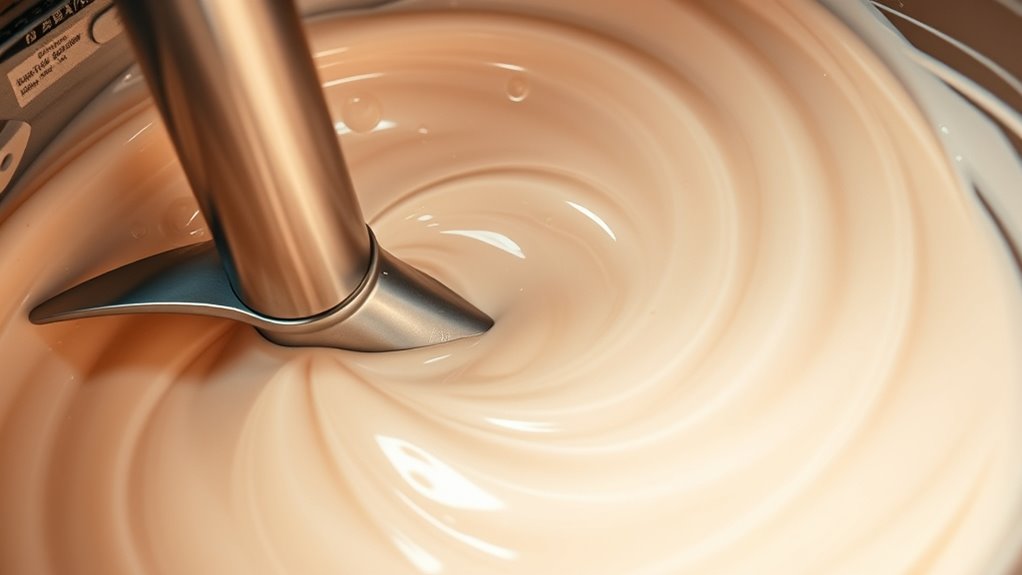
When you churn ice cream, air gets whipped into it, giving it a light and fluffy texture. Controlling the freezing point during churning guarantees the ice crystals stay small, making the ice cream smooth. This process also influences how the texture develops, balancing creaminess with structure for the perfect bite. Additionally, the type of spray tips used can affect the surface finish and overall appearance of the final product. Proper temperature control during churning is essential to achieve the desired consistency and prevent large ice crystal formation. To enhance texture, the incorporation of air is carefully managed to ensure optimal volume and creaminess in the finished product. Understanding essential oils and their properties can also inspire innovative flavors and aromas in ice cream creations. Maintaining a consistent mixing speed helps in achieving uniform texture and prevents air entrapment issues.
Air Incorporation Process
Have you ever wondered how ice cream achieves its creamy, fluffy texture? The air incorporation process during churning is key. As the mixture spins, tiny air bubbles are whipped into the base, creating a light, airy structure. Gelatin stabilization helps trap these bubbles, preventing them from collapsing and ensuring a stable, smooth texture. This process is essential to texture development because it influences the final mouthfeel of the ice cream. Additionally, the overrun, or the amount of air added, can be precisely controlled to achieve the desired creaminess: more air makes it fluffier, less creates a denser texture. This delicate balance relies on precise churning, where controlled air incorporation transforms the liquid mixture into the luscious ice cream you enjoy. Incorporating sound effects techniques can also help capture the subtle textures and ambient qualities associated with ice cream production, revealing how science enhances both texture and flavor in every scoop.
Freezing Point Control
As the air bubbles are incorporated during churning, the mixture begins to cool rapidly, and controlling the freezing point becomes essential to achieving the desired texture. Gelatin stabilization helps prevent large ice crystal formation, ensuring a smooth consistency. It acts as a barrier, limiting crystal growth and maintaining creaminess. Meanwhile, sugar crystallization plays a crucial role; the right sugar content lowers the freezing point, allowing the mixture to stay semi-liquid longer during freezing. This slow freezing process creates smaller ice crystals, which contribute to a velvety texture. By carefully managing these factors, the ice cream remains soft and scoopable, avoiding icy hardness. Effective freezing point control, consequently, hinges on balancing gelatin stabilization and sugar crystallization to produce perfect ice cream.
Texture Development Mechanisms
Churning ice cream actively incorporates air and evenly distributes ingredients, which directly influences its final texture and consistency. During this process, sugar crystallization is controlled to prevent large, gritty crystals, resulting in smoothness. A new sentence with texture control and the rest of the sentence. The agitation encourages tiny sugar crystals to form, giving the ice cream a creamy mouthfeel. Fat emulsification also plays an essential role; as churning mixes fat with water, it creates stable emulsions that contribute to a rich, velvety texture. Proper churning guarantees these emulsions are uniform, avoiding separation. Additionally, the mechanical action breaks down ice crystals, keeping them small and maintaining softness. The temperature regulation during churning is crucial to ensure optimal texture and prevent unwanted crystallization. Furthermore, crystal formation during freezing is influenced by the initial churning process, underscoring the importance of proper technique. The frozen state also impacts the final texture, as rapid freezing helps preserve small ice crystals and smoothness. Understanding the microstructure of ice cream reveals how microscopic components influence overall quality. Together, sugar crystallization and fat emulsification work in harmony, shaping the delightful, smooth, and consistent texture that makes ice cream so enjoyable.
The Role of Emulsifiers and Stabilizers in Ice Cream
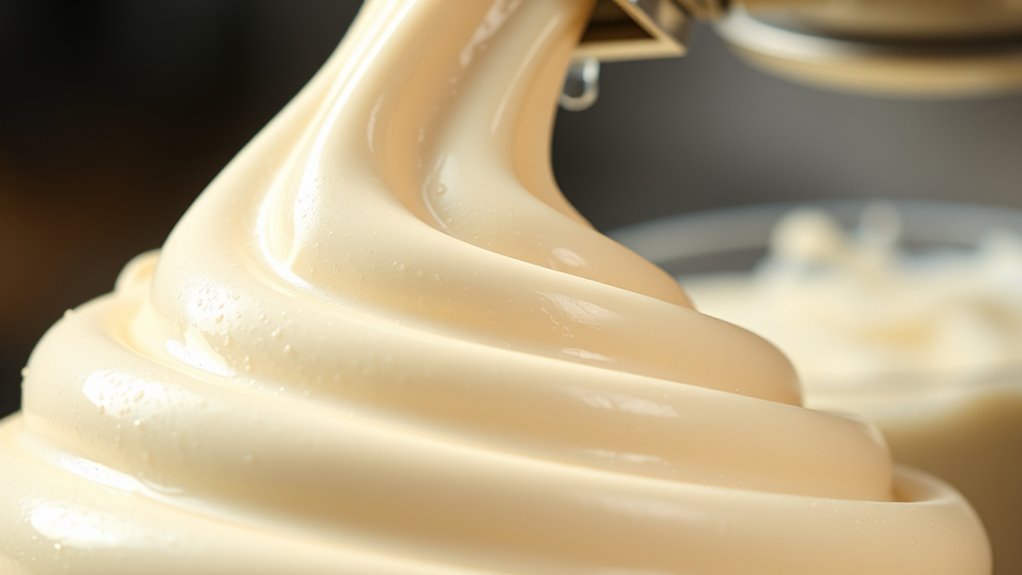
Ever wondered how ice cream stays smooth and creamy despite its icy exterior? That’s where emulsifiers and stabilizers come in. Emulsifier types, like lecithin or mono- and diglycerides, help blend fat and water, preventing separation. Stabilizer functions, such as guar gum or carrageenan, inhibit ice crystal growth and improve texture. They create a stable matrix that traps air and prevents ice crystals from enlarging. The science of stabilizers involves understanding how these ingredients work together to maintain ideal consistency. Here’s a quick look:
| Ingredient | Function | Effect |
|---|---|---|
| Lecithin | Emulsifier | Smooth, uniform texture |
| Guar gum | Stabilizer | Prevents ice crystal growth |
| Mono- and diglycerides | Emulsifier | Enhances creaminess |
| Carrageenan | Stabilizer | Improves mouthfeel |
| Gelatin | Stabilizer | Adds body and stability |
These ingredients work together to keep your ice cream irresistibly smooth, with proper formulation playing a crucial role in the final texture. Additionally, understanding the interactions between emulsifiers and stabilizers helps food scientists optimize ice cream quality. Recognizing the role of specific ingredients in different recipes can further enhance the final product’s quality. Moreover, the type of stabilizer used can influence the overall flavor profile and shelf life of the product.
The Engineering of Commercial Ice Cream Machines

You’ll see how cooling mechanisms keep the ice cream at the perfect consistency, whether through traditional compressors or innovative methods. Next, you’ll explore ingredient dispensing systems that precisely add flavors, mix-ins, and stabilizers during production. Understanding these engineering features reveals how commercial machines deliver consistent, high-quality ice cream every time. Additionally, tuning techniques are employed to optimize the performance of the machinery, ensuring efficiency and reliability in high-volume settings.
Cooling Mechanisms Unveiled
Understanding how commercial ice cream machines cool the mixture is essential to appreciating their engineering. These machines use advanced cooling mechanisms, often involving refrigeration systems that rapidly lower the mixture’s temperature. During the cooling process, gelatin stabilization plays a crucial role in maintaining the ice cream’s texture, preventing large ice crystal formation. This stabilization ensures a smooth, creamy consistency that passes sensory evaluation tests. The refrigeration system works efficiently by cycling refrigerants through coils, extracting heat quickly, and maintaining a consistent temperature. Precise control of cooling rates is vital, as uneven cooling can impact texture and flavor. By combining effective cooling mechanisms with gelatin stabilization, these machines produce high-quality ice cream with optimal sensory qualities, satisfying both technical standards and customer expectations.
Ingredient Dispensing Systems
Ingredient dispensing systems are integral to the precise and efficient operation of commercial ice cream machines. They allow you to easily create a variety of flavor combinations by accurately measuring and combining ingredients. These systems guarantee ingredient freshness by controlling storage conditions and minimizing exposure to air, which helps maintain ideal quality. Precise dispensing prevents over- or under-ingredients, resulting in consistent texture and flavor. You can switch between recipes effortlessly, improving productivity and customer satisfaction. Modern systems often feature automated controls, reducing manual labor and errors. By streamlining ingredient delivery, these systems help you serve high-quality ice cream with vibrant flavors and perfect consistency. Overall, ingredient dispensing systems are essential for delivering the freshest ingredients and the most delicious, innovative flavor combinations.
Innovations and Future Technologies in Ice Cream Production
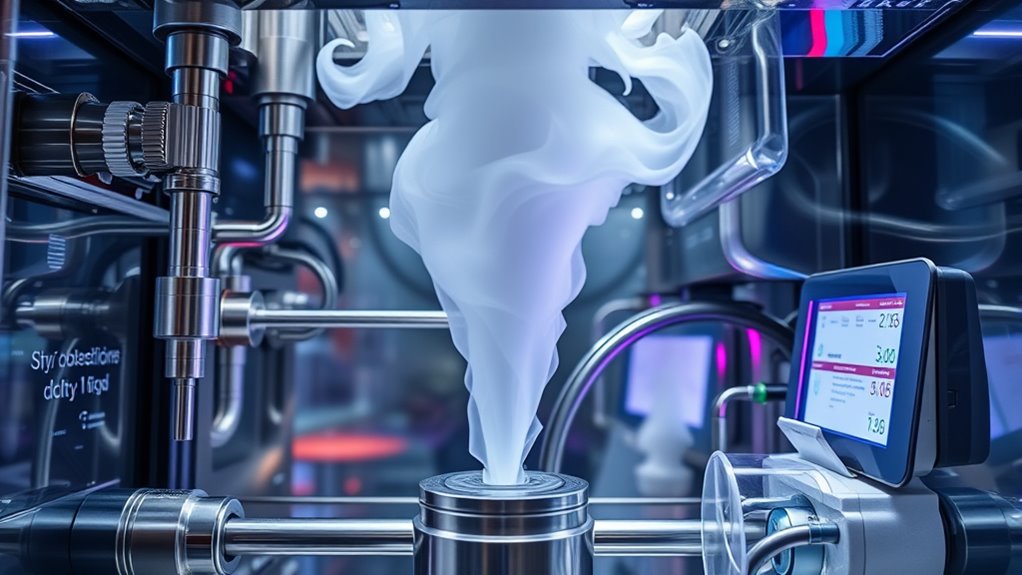
As technology advances, ice cream production is poised to become faster, more efficient, and highly customizable. Innovations like automated systems enable precise control over flavor and texture, while new machinery supports artisanal techniques for small-batch, handcrafted styles. Future tech also focuses on sustainability with eco-friendly packaging solutions that reduce waste. Imagine ice cream factories using biodegradable containers or reusable packaging that maintains freshness without harming the environment. Advanced freezing methods will improve texture consistency and speed up production. Here’s a snapshot of upcoming innovations:
| Technology | Benefit | Impact |
|---|---|---|
| Robotic Mixing | Precise ingredient blending | Consistent quality |
| Eco-friendly Packaging | Reduces environmental footprint | Sustainable consumer appeal |
| AI Flavor Customization | Personalized options | Enhanced customer experience |
| Rapid Freezing Tech | Faster production cycles | Increased efficiency |
| Artisanal Equipment | Supports handcrafted techniques | Unique, premium products |
The Science of Flavor Infusion and Texture Enhancement
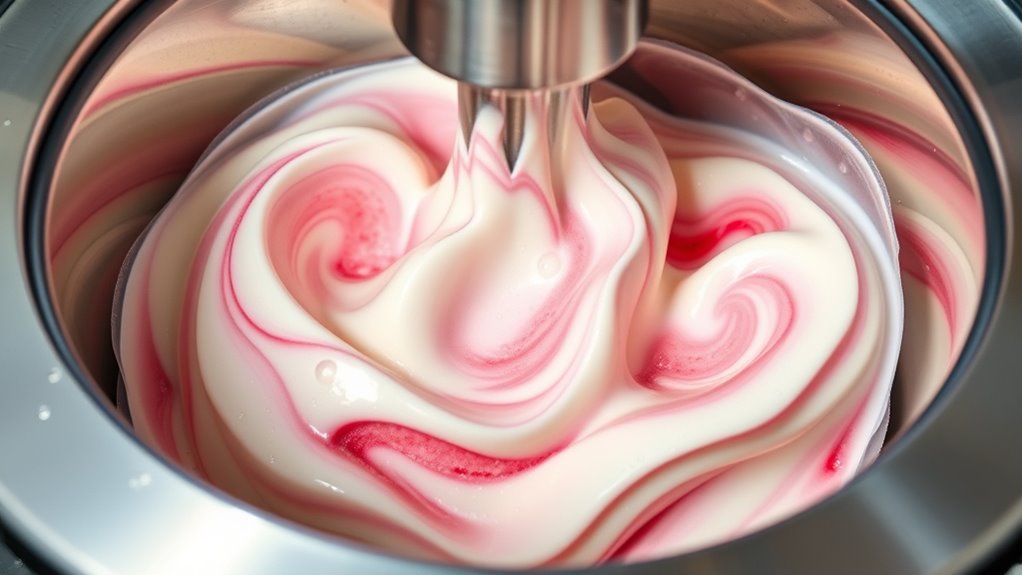
The science of flavor infusion and texture enhancement relies on precise control over how ingredients interact during the freezing process. You can optimize flavor pairing by selecting complementary ingredients that enhance each other’s taste and aroma, creating a richer sensory perception. As the ice cream freezes, the distribution of flavors influences how you perceive sweetness, tartness, or richness. Techniques like emulsification help incorporate smooth textures, while controlling crystal size improves creaminess. By understanding these processes, you can craft ice creams with complex flavor layers and satisfying textures. This scientific approach guarantees that every spoonful delivers a harmonious balance, elevating the overall sensory experience. Ultimately, mastering flavor infusion and texture enhancement allows you to create ice cream that’s not only delicious but also memorable.
Frequently Asked Questions
How Do Different Ingredients Affect Ice Cream’s Freezing Point?
You should know that ingredients like sugar concentration and fat content considerably influence ice cream’s freezing point. Higher sugar levels lower the freezing point, making it softer at colder temperatures, while increased fat content can also affect texture and melting rate. By adjusting these ingredients, you control how firm or soft your ice cream becomes. So, understanding their effects helps you craft the perfect frozen treat tailored to your desired texture.
What Are the Environmental Impacts of Commercial Ice Cream Machines?
Imagine a busy ice cream parlor, where commercial machines hum tirelessly. You might not see it, but these machines consume a lot of energy and generate waste through packaging and cleaning. This high energy use impacts the environment by increasing carbon footprints. Efficient waste management and energy-saving practices are essential to reduce this impact, helping you enjoy your treat while caring for the planet.
Can Ice Cream Machines Produce Dairy-Free or Vegan Options?
Yes, you can definitely make dairy-free or vegan options with ice cream machines. They work well with alternative ingredients like coconut milk, almond milk, or soy-based products, allowing you to customize flavors to suit dietary needs. With these options, you get great flavor customization while satisfying vegan or dairy-free preferences. Just make certain your machine is suitable for plant-based ingredients to achieve smooth, delicious results every time.
How Do Temperature Fluctuations Influence Ice Cream Quality During Production?
You should know that temperature fluctuations can seriously impact ice cream quality during production. Maintaining temperature stability with efficient cooling systems ensures the mixture freezes evenly, preventing ice crystals and texture issues. When temperatures fluctuate, it causes inconsistent freezing, resulting in grainy or soft ice cream. Consistent cooling keeps the ice cream smooth and creamy, so you get a better product. Proper temperature control is essential for premier ice cream quality.
What Roles Do Air Incorporation and Overrun Play in Perceived Creaminess?
You notice how air incorporation and overrun effects impact creaminess in ice cream. When your machine adds more air, the ice cream feels lighter and creamier, enhancing your enjoyment. Overrun, which measures the amount of air whipped into the mix, influences texture and perceived richness. Higher overrun makes the ice cream seem softer and more voluminous, giving you a smoother, more indulgent experience with every scoop.
Conclusion
Now that you understand the science behind ice cream machines, you can appreciate every scoop more deeply. Think of each bite as the result of precise thermodynamics, expert churning, and innovative tech working together. It’s easy to imagine these machines as tiny factories, transforming simple ingredients into a creamy masterpiece. So, next time you enjoy your favorite flavor, remember the fascinating science that makes it possible—your perfect scoop is a marvel of engineering and flavor science.
